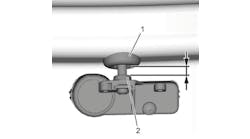This vehicle is equipped with an indirect tire pressure monitoring system (TPMS). The vehicle is not equipped with tire pressure sensors mounted on the wheels.
Whenever the pressure has been adjusted on one or more tires, tires have been rotated or one or more tires have been replaced, the TPMS must be calibrated. (See RESET PROCEDURES.)
The TPMS may not function properly if tire type and size are mixed. Make sure to use the same size and type of tire.
Instead of directly measuring the pressure in each tire with pressure sensors, the TPMS, on this vehicle, is controlled by the vehicle stability assist (VSA) modulator-control unit and it monitors and compares the rolling radius and rotational characteristics of each wheel and tire while driving to determine if one or more tires are significantly under-inflated.
Low tire pressure will cause the low tire pressure/TPMS indicator to come on and a message to appear on the multi-information display.
TIRE PRESSURE MONITOR WARNING INDICATORS
NOTE: The low tire pressure/TPMS indicator blinks for about one minute and then stays on under the following conditions:
• A compact spare tire is used;
• There is a heavier and uneven load on the tires, such as when towing a trailer, than the condition at calibration, and;
• Snow chains are used.
CAUTION: If the low tire pressure/TPMS indicator comes on even when the tires are properly inflated and the TPMS has been calibrated, see appropriate manufacturer service information.
If the system detects low tire pressure in any of the four tires, the low tire pressure/TPMS indicator comes on, as well as the message indicator. It will keep being turned on until calibration starts.
If a problem in the system is detected, the VSA indicator comes on, the CHECK SYSTEM message (TPMS) on the multi-information display (MID) is displayed and the low tire pressure/TPMS indicator comes on after blinking for about 75 seconds.
TPMS RESET PROCEDURES
Whenever the pressure has been adjusted on one or more tires, tires have been rotated or one or more tires have been replaced, the TPMS must be calibrated.
If the system detects low tire pressure in any of the four tires, the low tire pressure/TPMS indicator comes on, as well as the message indicator. It will keep being turned on until calibration starts.
TPMS CALIBRATION PROCEDURE
Calibration begins when the TPMS switch is pressed or calibration is selected through the MID or the center display. Calibration is completed after driving at 31 to 62 miles per hour (50 to 100 km/h) steadily - without much acceleration or deceleration - for about 18 minutes.
Full functionality of the system cannot be performed properly if the calibration is not completed The calibration method is determined by the vehicle's dashboard equipment. (See Models With Information Display, or Models With Center Display - Fig. 1.)
MODELS WITH INFORMATION DISPLAY
1) Make sure the tires are inflated to the specified tire pressure listed on the door jamb label.
NOTE: Vehicle must be stopped with the transmission in neutral (M/T; manual transmission) or Park (P) or Neutral (N) (automatic transmission; A/T), (Continuously Variable Transmission; CVT);
2) Turn the ignition switch to ON or press the engine start/stop button to select the ON mode;
3) Press the TPMS switch (A) for three seconds. (See Fig. 2;)
4) When the calibration successfully begins, the indicator (B) blinks twice
5) See Calibration Completion Check.
MODELS WITH MULTI-INFORMATION DISPLAY
1) Make sure the tires are inflated to the specified tire pressure listed on the door jamb label.
The vehicle must be stopped with the transmission in neutral (M/T) or park or neutral (A/T, CVT);
2) Turn the ignition switch to ON or press the engine start/stop button to select the ON mode;
3) Press and hold the INFORMATION button (A) to enter the VEHICLE SETTINGS mode. (See Fig. 3);
4) Press the SEL/RESET button (B) to select TPMS CALIBRATION;
5) When the calibration successfully begins, "Calibration Started" gets displayed on the MID (C) when the system receives the calibration;
6) See Calibration Completion Check.
NOTE: If the calibration does not begin successfully, "Calibration Failed to Start" gets displayed on the MID. See appropriate manufacturer troubleshooting information.
MODELS WITH CENTER DISPLAY
1) Make sure the tires are inflated to the specified tire pressure listed on the door jamb label;
Vehicle must be stopped with the transmission in neutral (M/T) or park or neutral (A/T, CVT);
2) Turn the ignition switch to ON or press the engine start/stop button to select the ON mode;
3) Select the HOME button on the screen. (See Fig. 4);
4) Select SETTINGS;
5) Select the VEHICLE (display audio type) or VEHICLE SETTINGS (color audio type);
6) Select TPMS CALIBRATION;
7) Select CALIBRATE;
8) When calibration successfully begins, "Calibration Started" is displayed on the screen when the system receives the calibration;
9) See Calibration Completion Check.
NOTE: If the calibration does not begin successfully, "Unable to initialize TPMS" is displayed on the screen. See appropriate manufacturer troubleshooting information.
CALIBRATION COMPLETION CHECK
Check if calibration is completed by doing the following:
1) Stop the vehicle and shift into neutral (M/T) or park or neutral (A/T, CVT) position;
2) Turn the ignition switch to LOCK or press the engine start/stop button to select the OFF mode;
3) Turn the ignition switch to ON (or press the engine start/stop button to select the ON mode and wait to see the low-pressure indicator come on for two seconds and then off;
4) Do not drive the vehicle and wait for 45 seconds, as-is;
5) If the calibration is completed, the indicator does not come on. If the calibration is not yet completed, then the indicator will come on for two seconds and then go off.
NOTE: The calibration check process will be interrupted if the vehicle moves. Do the troubleshooting if the indicator does not go off after two seconds, keeps blinking or stays on when the vehicle is in the ON mode.
DISMOUNTING/MOUNTING PROCEDURES
This vehicle is equipped with an Indirect TPMS System. The vehicle is not equipped with tire pressure sensors mounted on the wheels.
Whenever the pressure has been adjusted on one or more tires, tires have been rotated or one or more tires have been replaced, the TPMS must be calibrated. (See RESET PROCEDURES.)
CAUTION: The TPMS may not function properly if tire type and size are mixed. Make sure to use the same size and type of tire.
TORQUE SPECIFICATIONS
Component Ft. Lbs. (N.m)
Wheel Nut 80 (108)


